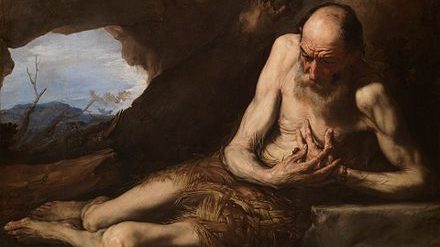St. Paul of Thebes was born around the year 230. He received a thorough education, including religious studies. His parents died when he was 15. When he was about 20, the Emperor Decius launched a vicious persecution of Christians, executing clergymen and forcing laymen to worship idols by torturing them and threatening to kill them.
Paul went into hiding during the persecution, but when he learned that one of his family members planned to betray him to the government, he decided to disappear. He found a large abandoned cave in a remote desert, and learned how to survive on spring water and the fruit of a nearby tree.
Although he was forced into the wilderness, Paul found that he loved the simplicity and prayer of his new life. He never returned to the outside world, even after the persecution ended. His hermetic way of life inspired Catholics who were seeking a deeper relationship with God through isolation and spiritual discipline. He lived in close communion with God until his death at age 113.
One of Paul’s disciples was St. Anthony of Egypt, a young man born near Cairo around the year 251. He decided to live in the desert and devote himself to God. Around the year 342, Anthony had a dream about Paul, and went to find him.
Paul had also received a dream about Anthony, and when Anthony found him, he greeted him by name. Anthony learned a great deal about Paul’s life, including that a bird had brought him a ration of bread every day for the last 60 years.
Paul knew that he was close to death, so he asked Anthony to return to his own hermitage, and bring back a cloak that Anthony had received from the bishop St. Athanasius. Anthony was amazed by Paul’s knowledge, because he had not mentioned the cloak, and Athanasius had not been born when Paul left the outer world. Anthony left Paul to do as he had asked.
On his way back, Anthony received a vision that Paul’s soul was ascending toward Heaven. He venerated Paul’s body, wrapped him in the cloak of St. Athanasius, and carried him out of the cave. According to St. Jerome in “Life of St. Paul the First Hermit,” two lions arrived, demonstrated reverence, and dug a grave for him.
Anthony took back the garment that Paul had woven for himself from palm leaves, and told the story of his journey, and of Paul’s life, to a group of monastic disciples. St. Jerome wrote down the accounts around the year 375, about 33 years after St. Paul’s death.

